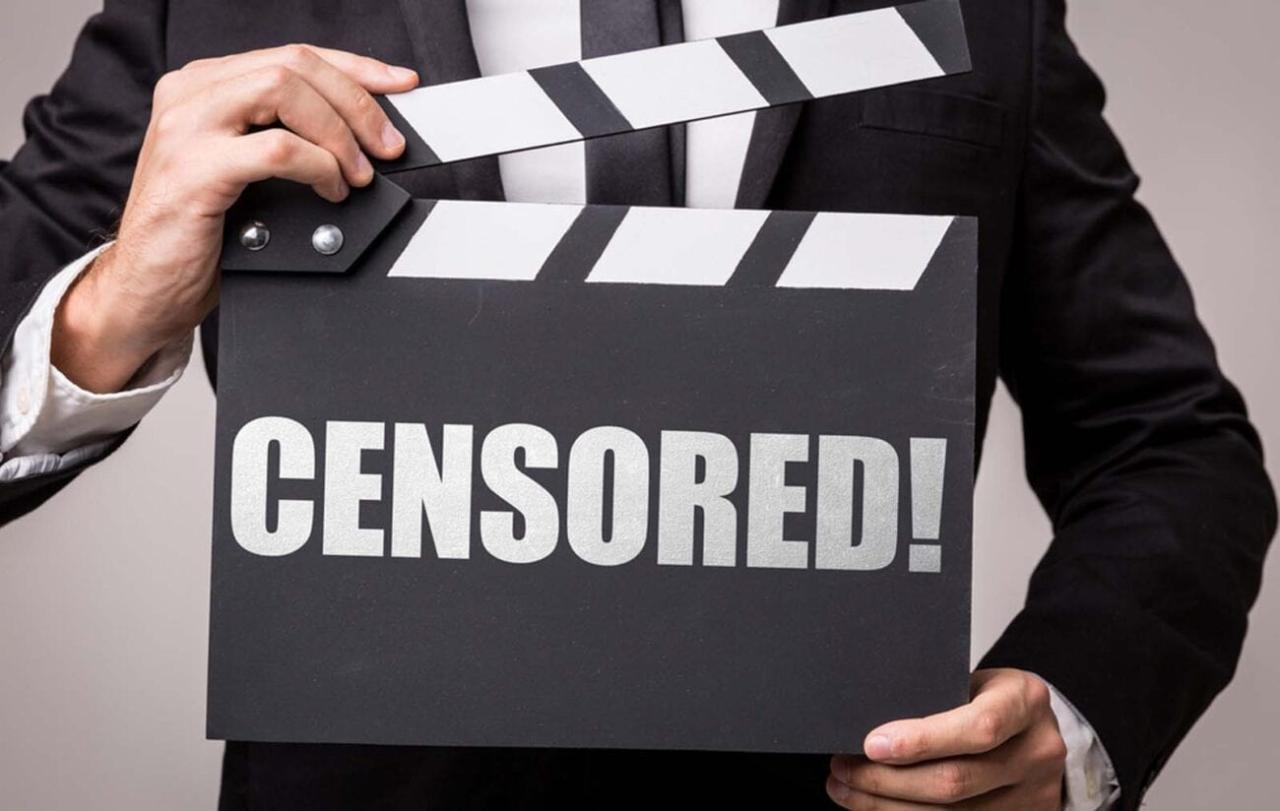Censorship Battles Over Mature Films represent a persistent tension between artistic expression and societal norms. This ongoing conflict shapes how we consume and create media, influencing everything from the content we see on screen to the very laws governing its distribution. The debate involves intricate legal frameworks, powerful industry players, and passionate public discourse, resulting in a complex landscape where creative freedom frequently clashes with concerns about morality and potential harm.
This exploration delves into the historical context of film censorship, examining the evolution of rating systems and the impact of societal shifts on regulatory practices. We’ll analyze the roles of government regulation and industry self-regulation, considering both their successes and shortcomings. Furthermore, the influence of technology and the rise of streaming platforms will be examined, highlighting the unique challenges they present for content control. Finally, we’ll explore the economic implications of censorship, its effect on artistic expression, and the ongoing dialogue between creators, audiences, and regulators.
Historical Context of Censorship in Film
The history of film censorship is intrinsically linked to the evolution of cinema itself, reflecting shifting societal values, moral anxieties, and political agendas. From its nascent stages as a novelty to its current status as a major global industry, film has consistently faced scrutiny and attempts at control, often mirroring broader cultural conflicts and power dynamics. This examination will trace the significant milestones in film censorship, highlighting the development of rating systems and the impact of societal pressures.
The interplay between artistic expression and societal expectations has shaped the landscape of film censorship. Moral panics, often fueled by anxieties surrounding violence, sexuality, and subversive ideologies, have repeatedly led to calls for greater regulation. Conversely, the rise of artistic movements and the fight for freedom of expression have spurred challenges to restrictive censorship practices. This tension has resulted in a constantly evolving regulatory environment, varying significantly across countries and time periods.
A Timeline of Major Censorship Events Impacting Mature Films
The early years of cinema witnessed relatively little formal censorship, though local authorities often intervened on a case-by-case basis. However, as film’s popularity exploded, so did concerns about its potential influence. The Hays Code, implemented in the United States in 1930, stands as a prime example of a comprehensive, industry-self-regulated censorship system. This code, enforced by the Motion Picture Producers and Distributors of America (MPPDA), severely restricted depictions of violence, sexuality, and other themes deemed morally objectionable. Its influence extended beyond the US, impacting international film production and distribution. The eventual decline of the Hays Code in the 1960s reflected a changing social climate and growing demand for greater artistic freedom. The subsequent rise of film rating systems marked a shift towards a more nuanced approach to content regulation, though debates about appropriateness continue. Further examples include the British Board of Film Classification’s (BBFC) long history of regulating film content in the United Kingdom, adapting its guidelines to reflect evolving social attitudes.
The Evolution of Film Rating Systems Globally
The need for more flexible and transparent film classification led to the development of rating systems worldwide. The Motion Picture Association of America (MPAA) rating system in the United States, introduced in 1968, categorized films based on content, providing parents with guidance on age appropriateness. Similar systems emerged in other countries, each reflecting unique cultural norms and legal frameworks. The BBFC in the UK, for instance, employs a different rating scale than the MPAA, yet serves a similar purpose. These systems, while intended to inform consumers, have also become points of contention, with ongoing debates about the effectiveness and consistency of their application. The diversity in rating systems across the globe underscores the cultural relativity of censorship and the challenges in establishing universal standards for mature content.
The Influence of Societal Norms and Moral Panics on Censorship
Moral panics, often driven by media portrayals and public anxieties, have profoundly influenced film censorship throughout history. The perceived threat of films corrupting morals or inciting violence has frequently led to calls for stricter regulations. For example, the anxieties surrounding juvenile delinquency in the mid-20th century contributed to increased censorship of films depicting youth rebellion or criminal activity. Similarly, concerns about the portrayal of violence and its impact on viewers have consistently shaped debates about film ratings and content restrictions. The evolution of societal norms surrounding sexuality and gender has also had a significant impact, with films depicting explicit sexual content or LGBTQ+ themes facing increased scrutiny at various points in history. These moral panics, though often fueled by exaggerated fears, have demonstrably influenced the development and enforcement of film censorship policies globally.
The Role of Government Regulation
Government regulation of film censorship varies significantly across the globe, reflecting diverse cultural values, political systems, and legal traditions. The level of control, the methods employed, and the rationale behind censorship decisions all contribute to a complex and often contentious landscape. Understanding these variations is crucial to appreciating the ongoing debates surrounding artistic freedom and societal protection.
The influence of government regulation on film censorship is multifaceted. It establishes the legal framework within which films are produced, distributed, and exhibited. This framework can range from relatively laissez-faire approaches, where government intervention is minimal, to highly restrictive systems with extensive pre-release censorship boards. The impact of these regulatory frameworks extends beyond simple approval or rejection; they also shape the creative choices filmmakers make, influencing the content, themes, and styles of films produced within a particular jurisdiction.
Comparison of Censorship Laws Across Countries
Several countries offer contrasting examples of film censorship. The United States, for instance, utilizes a ratings system (e.g., G, PG, PG-13, R, NC-17) rather than direct censorship, relying on self-regulation by the Motion Picture Association (MPA). This system allows for a degree of freedom of expression while providing guidance to parents. In contrast, countries like China maintain a strict pre-release censorship system, where films must be approved by government bodies before distribution. This often leads to significant alterations or outright bans of films deemed politically sensitive or morally objectionable. Singapore, too, employs a stringent censorship framework with a focus on maintaining social order and preventing the spread of potentially harmful content. These varying approaches highlight the diverse ways governments balance artistic freedom with societal concerns.
A Hypothetical Legal Framework for Film Censorship
A balanced legal framework for film censorship should prioritize freedom of expression while acknowledging the need to protect vulnerable groups from harm. It could incorporate a multi-tiered system, potentially including: (1) A classification system similar to the MPA rating system, providing clear guidelines for age appropriateness and content warnings; (2) A regulatory body responsible for reviewing appeals against classifications and addressing complaints about harmful content; (3) Legal recourse for filmmakers who believe their work has been unfairly censored; and (4) Education and awareness campaigns to promote media literacy and responsible consumption of film. This approach seeks to empower viewers with information while safeguarding against extreme forms of censorship.
Examples of Successful and Unsuccessful Government Interventions
The success or failure of government interventions in film censorship often depends on the specific context and the implementation of the regulatory framework. The MPA rating system in the United States, while not without its critics, is generally considered a relatively successful model because it allows for a wide range of expression while providing consumers with information to make informed choices. Conversely, excessively restrictive censorship systems, such as those in some authoritarian regimes, often stifle creativity and lead to a homogenization of film content, ultimately proving unsuccessful in achieving a balance between freedom of expression and societal protection. The impact of government intervention is therefore contingent on transparency, accountability, and a commitment to upholding fundamental rights.
The Impact of Self-Regulation by the Film Industry
The film industry’s attempts at self-regulation, primarily through rating systems, represent a complex interplay between commercial interests, societal expectations, and the desire to avoid government intervention. These systems aim to provide parents and viewers with information about a film’s content, allowing them to make informed choices, while simultaneously protecting the industry from potentially restrictive legislation. However, the effectiveness of these systems remains a subject of ongoing debate.
Self-regulation, while offering the industry a degree of autonomy, presents inherent challenges. The primary concern revolves around the potential for bias, the influence of commercial pressures, and the inherent difficulty in creating a universally accepted standard for content appropriateness. Different cultures and societies have varying sensitivities regarding violence, sexuality, and language, making the creation of a globally consistent rating system a near-impossible task. Further complicating matters are the evolving societal norms and technological advancements that continuously reshape the landscape of acceptable content.
Effectiveness of the MPAA Rating System
The Motion Picture Association of America (MPAA) rating system, established in 1968, is arguably the most well-known example of film industry self-regulation. Its effectiveness is a matter of ongoing discussion. While it provides a framework for parents to gauge the suitability of films for their children, criticisms include inconsistencies in application, the influence of commercial considerations on ratings decisions, and the limitations of the system in capturing the nuances of complex themes. For example, two films with similar levels of violence might receive different ratings depending on context or other factors. Furthermore, the system’s reliance on a relatively small rating board has led to accusations of bias and a lack of transparency. Studies on the effectiveness of the MPAA in reducing underage exposure to inappropriate content have yielded mixed results, with some suggesting a positive impact, while others highlight its limitations.
Comparative Analysis of International Film Rating Systems
Different countries and regions employ diverse approaches to film rating, reflecting their unique cultural values and legal frameworks. Some systems are more lenient than others, while others are more restrictive. These variations highlight the challenges of establishing a universal standard for content appropriateness. The absence of a globally harmonized system often leads to difficulties in the distribution and marketing of films across international borders.
| Country | Rating System | Description | Key Characteristics |
|---|---|---|---|
| United States | MPAA (Motion Picture Association of America) | Uses ratings G, PG, PG-13, R, and NC-17, based on content such as violence, language, and sexual content. | Industry self-regulation, widely adopted, subject to criticism for inconsistencies and commercial influence. |
| United Kingdom | BBFC (British Board of Film Classification) | Uses a system of age-based ratings, including U, PG, 12A, 12, 15, and 18. | Government-regulated, independent body, detailed guidelines and descriptions for each rating. |
| Canada | Canadian Film Classification System | Employs a system of age-based ratings, including G, PG, PG-14, 18A, and R. Regional variations exist. | Federal government oversight, focuses on age-appropriateness, considers both content and context. |
The Influence of Technology and Distribution
The advent of digital technologies and the rise of streaming platforms have fundamentally altered the landscape of film distribution and, consequently, censorship practices. The ease and speed with which content can be uploaded and accessed globally presents unprecedented challenges to traditional methods of content regulation. This section will explore the impact of these technological advancements on censorship, focusing on the difficulties of regulating online distribution and the legal and ethical dilemmas posed by user-generated content.
The proliferation of streaming platforms like Netflix, Amazon Prime Video, and Hulu has significantly impacted censorship practices. Unlike traditional broadcast television or cinema, which are subject to stricter regulatory frameworks, streaming services often operate under a more self-regulatory model. While they may have internal guidelines regarding acceptable content, these guidelines vary considerably and are often less stringent than those imposed by governments on broadcast media. This difference creates a complex and uneven playing field for content creators and consumers, with the potential for inconsistencies in the application of censorship across different platforms. Furthermore, the global reach of these platforms complicates matters, as they must navigate the diverse censorship laws and cultural norms of numerous countries. For instance, a film deemed acceptable in one country might be banned in another, forcing streaming services to employ geo-blocking or content modifications to comply with local regulations.
Streaming Platforms and Censorship Practices
Streaming platforms exert a considerable influence on censorship by virtue of their control over content selection and distribution. Their algorithms and curation practices can subtly shape audience access to mature films, effectively acting as a form of implicit censorship. For example, the prominence given to certain titles within a platform’s recommendations can significantly impact viewership, while the absence of particular films, even without explicit censorship, can limit audience exposure. Moreover, the ability of platforms to implement age verification systems and parental controls impacts the accessibility of mature content to younger audiences. However, the effectiveness of these measures is constantly challenged by technological advancements and user ingenuity, creating an ongoing struggle to balance accessibility and responsible content moderation. The use of algorithms in content recommendation can also lead to filter bubbles, where users are primarily exposed to content that aligns with their pre-existing preferences, potentially limiting exposure to diverse viewpoints and mature themes.
Challenges of Regulating Online Distribution of Mature Films
Regulating the online distribution of mature films presents significant challenges. The decentralized nature of the internet, coupled with the sheer volume of content uploaded daily, makes comprehensive monitoring and enforcement extremely difficult. Traditional methods of censorship, such as pre-screening films before release, are largely ineffective in the online environment. Furthermore, the ease with which content can be copied and shared across different platforms makes it difficult to control the distribution of material deemed inappropriate. The use of virtual private networks (VPNs) and other anonymizing technologies further complicates the process of tracking and removing illegal or objectionable content. International jurisdiction also poses a significant obstacle; determining which country’s laws apply to content hosted on servers in different locations is a complex legal issue. The lack of a unified global regulatory framework for online content adds to the challenge.
Legal and Ethical Implications of User-Generated Content Involving Mature Themes
User-generated content (UGC) platforms, such as YouTube and social media sites, present unique challenges regarding mature themes. While these platforms often have community guidelines that prohibit certain types of content, enforcing these guidelines consistently is a major hurdle. The sheer volume of UGC uploaded daily, combined with the difficulty of automatically identifying and removing inappropriate material, necessitates a reliance on user reporting and algorithmic detection, both of which are imperfect systems. The legal implications of UGC involving mature themes are complex, encompassing issues of defamation, copyright infringement, and the potential for the spread of harmful or illegal material. Ethical considerations also arise, particularly concerning the potential for exposure of minors to inappropriate content and the balance between freedom of expression and the need to protect vulnerable individuals. The development of effective mechanisms for content moderation that respects both individual rights and community safety remains a significant ongoing challenge.
Artistic Expression vs. Public Morality
The ongoing debate surrounding censorship of mature films highlights a fundamental tension: the inherent right to artistic expression versus societal concerns about the potential harm of explicit content. This conflict necessitates a careful balancing act, weighing the benefits of unrestricted creativity against the potential negative impacts on audiences, particularly vulnerable populations. Finding this equilibrium remains a significant challenge for lawmakers, industry regulators, and the public alike.
The crux of the matter lies in defining “harmful content.” What constitutes unacceptable levels of violence, sexuality, or other potentially offensive material is subjective and often culturally influenced. This subjectivity makes establishing universally accepted censorship standards extremely difficult, leading to ongoing and often heated public discourse. Furthermore, the potential for censorship to stifle artistic innovation and limit the exploration of complex social issues is a significant counter-argument.
Examples of Films that Sparked Censorship Debates
Several films have become focal points in censorship debates, often pushing the boundaries of acceptable content and sparking significant public reaction. These debates frequently highlight the challenges of balancing artistic expression with community standards. For instance, the 1960s saw significant controversy surrounding films like “Bonnie and Clyde,” which depicted graphic violence, and “Midnight Cowboy,” which contained explicit sexual content. More recently, films like “The Passion of the Christ” and “Natural Born Killers” generated intense debate about their depictions of violence and religious themes. The reaction to these films, and the resulting censorship attempts, illustrate the ever-evolving nature of public morality and its impact on cinematic expression.
Arguments for Stricter Censorship of Mature Films
Proponents of stricter censorship often argue that certain types of content pose a direct threat to public morality and well-being. They might point to studies suggesting a correlation between exposure to violent media and aggressive behavior, or raise concerns about the potential for sexually explicit content to normalize harmful attitudes and behaviors. The argument for stricter regulation frequently emphasizes the need to protect vulnerable populations, such as children, from exposure to material deemed inappropriate for their age group. This perspective emphasizes a precautionary approach, prioritizing the potential harm of unrestricted content over the potential limitations on artistic expression. Furthermore, some proponents advocate for stricter censorship as a means to uphold societal values and prevent the normalization of behaviors considered morally objectionable. The potential for media to influence attitudes and behaviors is a key element of this argument.
The Economic Impact of Censorship
Censorship significantly impacts the profitability of mature films, affecting various stages of production, distribution, and marketing. The restrictions imposed can limit potential audiences, increase production costs, and complicate international distribution, ultimately reducing the film’s financial returns. The level of impact varies depending on the severity and nature of the censorship, the film’s genre, and the target market.
Censorship directly affects a film’s potential revenue by limiting its accessibility to audiences. Stricter censorship can lead to a film being banned outright in certain territories, preventing any revenue generation from those markets. Even less severe forms of censorship, such as requiring cuts or edits to secure a release, can reduce the film’s appeal to its intended audience, leading to lower box office takings and reduced home video sales. Furthermore, the costs associated with appealing censorship decisions or making the necessary edits can significantly eat into a film’s budget, reducing its overall profitability.
Examples of Films Impacted by Censorship
The impact of censorship on film profitability is evident in numerous examples. Consider the challenges faced by films dealing with controversial topics like sexuality, violence, or political dissent. For instance, certain scenes in the original release of “The Passion of the Christ” (2004) sparked controversy and prompted calls for censorship in some countries, though the film ultimately achieved significant box office success despite the debate. Conversely, other films, less commercially successful, might have seen their distribution severely limited due to censorship, hindering their potential to recoup production costs and generate profit. The specific financial losses in these cases are difficult to definitively quantify due to the complex interplay of various factors influencing box office performance. However, the potential for lost revenue is undeniable. The impact is not only financial but also reputational, potentially harming the careers of filmmakers and actors involved.
Potential Economic Benefits of Less Restrictive Censorship Policies
Less restrictive censorship policies could unlock significant economic benefits for the film industry. A more permissive environment would allow filmmakers greater creative freedom, potentially leading to the production of more innovative and commercially successful films that cater to a wider range of audiences. This could result in increased box office revenue, higher home video sales, and a more vibrant and competitive film market. Moreover, a less censored environment could attract international investment and talent, further boosting the industry’s economic growth. The potential economic benefits are not limited to the film industry itself; a flourishing film sector can contribute to tourism, employment opportunities, and the overall economic development of a region or country. For example, countries known for their liberal film policies often attract international film productions, generating significant revenue and job creation.
The Censorship of Specific Themes in Mature Films: Censorship Battles Over Mature Films
Mature films, by their very nature, often explore themes considered taboo or controversial by certain segments of society. This inevitably leads to clashes with censorship boards and regulators, resulting in alterations, bans, or restrictions on distribution. The specific themes targeted and the intensity of censorship vary significantly across cultures and time periods, reflecting differing societal values and legal frameworks.
The recurring themes frequently targeted by censors are broadly categorized as violence, sexuality, and profanity, often intertwined and amplified by other potentially sensitive elements like drug use, political dissent, or graphic depictions of violence. These themes, when presented explicitly or implicitly, can trigger reactions ranging from discomfort to outrage, prompting calls for censorship to protect perceived public morality or national security.
Recurring Themes and Censorship
Censors consistently focus on graphic depictions of violence, particularly when it involves gratuitous gore, sexual assault, or the glorification of violence. The level of acceptable violence varies drastically; a film considered acceptable in one country might be heavily censored or banned in another. For instance, a film depicting realistic war violence might be accepted in a country with a strong military tradition but heavily edited or banned in a country with stricter regulations on on-screen violence. Similarly, depictions of sexual acts, particularly those involving non-consensual sex or explicit displays, are frequently targeted. While some cultures have more liberal attitudes towards nudity and sexual content, others maintain strict prohibitions. The representation of LGBTQ+ relationships also often faces censorship, with some countries banning films that depict homosexuality or transgender identities.
Cross-Cultural Comparison of Censorship
A comparison of censorship across different cultural contexts reveals striking differences. Countries with strong religious or conservative traditions tend to impose stricter censorship on themes deemed morally objectionable. For example, films depicting nudity or sexual activity might face significant cuts or bans in predominantly Muslim countries, while countries with more liberal social attitudes may have less restrictive regulations. Conversely, countries with authoritarian governments might censor films that contain political dissent or criticism of the ruling power, regardless of their sexual or violent content. This demonstrates how cultural norms and political climates heavily influence censorship practices.
Visual Representation of Censorship Levels
The following text-based table illustrates varying levels of censorship applied to different themes across three hypothetical countries: Country A (liberal), Country B (moderate), and Country C (conservative).
| Theme | Country A (Liberal) | Country B (Moderate) | Country C (Conservative) |
|---|---|---|---|
| Graphic Violence | Minimal Censorship | Moderate Censorship (some cuts) | Heavy Censorship (significant cuts or ban) |
| Explicit Sexuality | Moderate Censorship (some scenes may be cut) | Heavy Censorship (significant cuts or NC-17 rating) | Ban |
| Profanity | Minimal Censorship | Moderate Censorship (some words muted or removed) | Heavy Censorship (significant cuts or dubbing) |
| LGBTQ+ Themes | Minimal Censorship | Moderate Censorship (subtle changes) | Heavy Censorship (removal of scenes or ban) |
This simplified representation highlights the vast differences in censorship approaches based on cultural and political contexts. The actual levels of censorship can be much more nuanced and depend on many factors beyond the themes depicted in the film.
The Role of Public Opinion and Advocacy Groups

Public opinion significantly shapes the landscape of film censorship, influencing both governmental policies and industry self-regulation. The interplay between public sentiment, expressed through various channels, and the actions of advocacy groups, both pro- and anti-censorship, creates a dynamic and often contentious environment surrounding the regulation of mature films. The effectiveness of these groups hinges on their ability to mobilize public support and exert pressure on relevant decision-makers.
Public opinion, often gauged through polls, surveys, and media commentary, reflects prevailing societal attitudes towards sexuality, violence, and other potentially offensive content. A shift in public opinion, perhaps driven by changing social norms or high-profile controversies, can lead to adjustments in censorship policies, either through legislative action or changes in industry self-regulatory practices. For instance, a growing public acceptance of LGBTQ+ themes might result in less restrictive ratings for films depicting such themes. Conversely, a surge in public concern over violence in films could prompt calls for stricter regulations.
Influence of Public Opinion on Censorship Decisions
Public opinion exerts its influence on censorship decisions through several avenues. Directly, it can shape the political climate, leading elected officials to adopt or reject stricter censorship laws. Indirectly, it can influence the decisions of rating boards and film studios, who are sensitive to potential public backlash against films deemed too controversial. Media coverage plays a crucial role in shaping public opinion, amplifying certain concerns while downplaying others. The intensity and consistency of public opinion, whether expressed through organized campaigns or casual conversation, can have a significant impact on the level of censorship imposed on films. For example, the intense public debate surrounding the depiction of violence in video games has influenced the creation and enforcement of ratings systems.
Activities of Advocacy Groups, Censorship Battles Over Mature Films
A wide range of advocacy groups actively participate in the censorship debate. Organizations advocating for stricter censorship often focus on protecting children from potentially harmful content, citing concerns about the impact of violence and sexually explicit material on young viewers. They employ tactics such as lobbying, public awareness campaigns, and legal challenges to promote their agenda. Conversely, groups advocating for less restrictive censorship emphasize the importance of artistic expression and freedom of speech. They argue that censorship limits creativity and can be used to suppress dissenting voices. Their strategies include legal action to challenge censorship rulings, public education initiatives to raise awareness of censorship’s negative effects, and collaborations with filmmakers to challenge restrictive practices.
Comparison of Advocacy Group Strategies
Pro-censorship groups frequently utilize strategies aimed at mobilizing public support through emotionally charged appeals, focusing on the potential negative impact of mature content on children and families. They often rely on lobbying efforts to influence legislation and engage in public relations campaigns to shape public perception. In contrast, anti-censorship groups often emphasize the importance of artistic freedom and the potential for censorship to stifle creativity. Their strategies include legal challenges to censorship decisions, advocating for changes in rating systems, and promoting media literacy initiatives to help audiences engage critically with film content. Both sides may use public demonstrations, petitions, and media appearances to further their objectives. The effectiveness of these strategies depends on a number of factors, including the resources available to the groups, the prevailing public sentiment, and the political climate.
The Future of Censorship in the Digital Age
The rapid advancement of digital technologies, particularly artificial intelligence (AI) and virtual reality (VR), presents unprecedented challenges and opportunities for film censorship. The decentralized and immersive nature of these technologies makes traditional regulatory frameworks increasingly inadequate, requiring innovative approaches to navigate the complex interplay between artistic expression, technological innovation, and public morality. The metaverse, in particular, presents a unique frontier where the lines between the physical and digital worlds blur, demanding a reconsideration of existing censorship models.
The proliferation of AI-generated content adds another layer of complexity. AI tools can be used to create highly realistic and potentially offensive material, raising concerns about the ease with which such content can be distributed and the difficulty in tracing its origins. Simultaneously, AI could also play a role in developing more sophisticated content filtering systems, capable of identifying and removing harmful material more effectively than current methods. The development and deployment of such AI-powered censorship tools, however, raises ethical concerns about algorithmic bias and potential for misuse.
Challenges and Opportunities of Censorship in the Metaverse
The metaverse, a persistent, shared, 3D virtual world, presents a unique challenge for content regulation. Its immersive nature and potential for user-generated content create a fertile ground for the dissemination of mature or harmful material. However, the metaverse also offers opportunities for innovative self-regulatory mechanisms and user-driven content moderation tools. For example, virtual spaces could employ age-verification systems and personalized content filters, allowing users to control their exposure to mature content. Furthermore, the development of robust reporting mechanisms and community-based moderation could empower users to actively shape the content landscape within the metaverse. The key challenge lies in balancing user autonomy and freedom of expression with the need to protect users from harmful content. The success of such a balance will depend on the development of transparent and accountable governance structures within the metaverse. Real-world examples of online communities successfully moderating their content, such as Reddit’s subreddit system, could provide valuable insights for developing such frameworks in the metaverse.
A Hypothetical Regulatory Framework for VR Mature Content
A regulatory framework for mature content in VR needs to consider the unique immersive nature of the medium. A multi-layered approach, combining technological solutions, industry self-regulation, and government oversight, could be effective. This framework could incorporate age-verification systems using biometric data, similar to those used for online gambling, coupled with robust content rating systems that clearly indicate the level of maturity of VR experiences. Furthermore, VR platforms could be required to provide users with granular control over their exposure to mature content, allowing them to customize their experience and filter out unwanted material. Government oversight would focus on ensuring the effectiveness of these systems, investigating and addressing instances of non-compliance, and promoting transparency and accountability. The framework should prioritize user safety and well-being while also upholding principles of free expression. This approach mirrors the existing regulatory landscape for video games, where rating systems and age verification play a significant role in managing content appropriateness.
Case Studies of Censorship Battles
The history of cinema is interwoven with battles over censorship, reflecting societal anxieties and evolving standards of morality. These conflicts, often pitting artistic expression against public morality and government regulation, have profoundly shaped the landscape of mature films and their distribution. Examining specific instances provides valuable insight into the complexities of these ongoing debates.
The Case of *The Birth of a Nation* (1915)
D.W. Griffith’s *The Birth of a Nation*, a landmark in cinematic technique, also became a notorious example of how film could perpetuate harmful stereotypes and historical inaccuracies. Its glorification of the Ku Klux Klan and deeply racist portrayal of African Americans sparked widespread protests and calls for censorship. While not formally banned nationwide, its controversial content fueled early discussions about film regulation and the power of moving images to influence public opinion. The film’s impact demonstrated the potential for censorship to be wielded not just to suppress explicit content but also to control the narrative and shape historical understanding.
- The film’s technical innovations were groundbreaking, yet its racist content sparked significant controversy.
- Protests and calls for censorship highlighted the potential for film to influence social attitudes.
- The controversy contributed to early debates surrounding film regulation and the societal impact of cinematic storytelling.
The Hays Code and its Enforcement
The Motion Picture Production Code, better known as the Hays Code (1930-1968), represented a period of self-regulation within the American film industry. Driven by concerns about public morality and the potential for negative influence, the Code imposed strict guidelines on content, prohibiting depictions of nudity, sexual situations, and violence. While intended to avoid government intervention, the Code’s impact was far-reaching, shaping the themes and narrative styles of Hollywood films for decades. Its eventual demise, however, demonstrated the limitations of self-regulation in the face of changing social attitudes and technological advancements.
- The Hays Code exemplified a period of self-censorship within the film industry.
- Its strict guidelines significantly impacted the themes and styles of Hollywood films for decades.
- The eventual abandonment of the Code highlighted the challenges of maintaining self-regulation in a dynamic cultural landscape.
The Battles Over *Midnight Cowboy* (1969)
John Schlesinger’s *Midnight Cowboy*, a groundbreaking film exploring themes of loneliness and survival in New York City, initially received an X rating from the Motion Picture Association of America (MPAA). This rating effectively limited its theatrical distribution, prompting a legal battle that eventually led to the film receiving an R rating and critical acclaim. This case highlighted the tension between artistic expression and the MPAA’s rating system, and its outcome influenced subsequent discussions about the criteria used to assign ratings and the impact of those ratings on a film’s commercial success.
- The initial X rating for *Midnight Cowboy* restricted its theatrical release, leading to a legal challenge.
- The subsequent R rating demonstrated the impact of legal battles on film classification and distribution.
- The case highlighted the tension between artistic expression and the MPAA’s rating system and its influence on a film’s commercial viability.
Conclusion
The ongoing battles over censorship in mature films reveal a dynamic interplay between artistic freedom, societal values, and technological advancements. While the quest for a perfect balance remains elusive, understanding the historical context, legal frameworks, and evolving technological landscape is crucial. The future of film censorship likely lies in finding innovative solutions that respect creative expression while addressing legitimate concerns about harmful content, fostering a responsible and engaging media environment for all.






